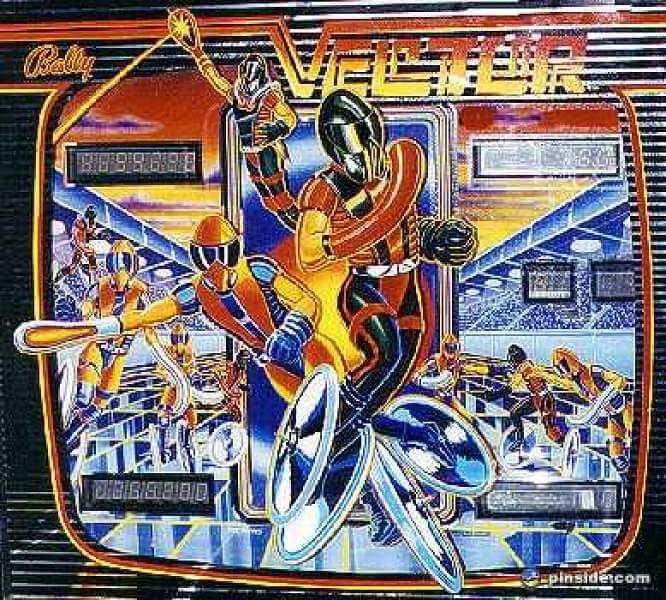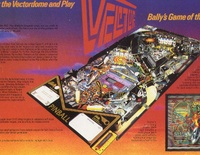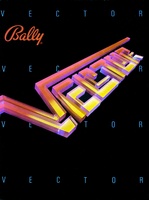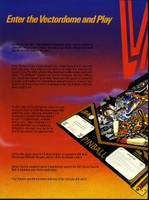

Vector
Unlike other Bally electronic pinball games, their documentation for this game shows the model number only as 1247, not 1247-E. Designer Greg Kmiec's signature red post is located near the upper right flipper on this game. Artist Greg Freres offers some interesting information about the evolution of a design team:Vector was a bit of an experiment when it came to the design philosophy at that time. We were in the midst of trying to save pinball from the video monster and I'm not sure who it was, but the idea of working as a complete "team" was introduced as a concept to hopefully improve upon the design from the ground up by allowing more ideas to flow into the process. Before this the design group would build whitewoods, play them, tweak them, and then decide which of them would become the next game. Some of the games had more input from art or marketing from the inception, like Xenon, but for the most part the games would get blessed by Norm [Clark], etc and get sent to the art department for the finished theme and package. With Vector, I recall having meetings with a team of maybe five to ten people, including Greg Kmiec and people from other areas, maybe sound, mechanical, and electrical included (?). Greg was the project leader and we all brainstormed together to come up with unique features, the theme, and other design elements. Greg Kmiec summed it up this way:Bally tried an experiment of "team designing" games. Each team had a designer, programmer, artist and solid state/sound person on it. The goal was to design a game with everyone's input. I remember that VECTOR was one of the games that came out of the team design concept because I was the designer on that team. As you can tell by the number of features on it, VECTOR was indeed designed by committee. The experiment was abandoned after each team's first game. The 1982 Bally/Midway pinball parts catalog page 41 indicates the top flipper is the same part number and uses the same size rubber ring as the two 3-inch flippers at the bottom of the playfield. However, every game we have seen has the shorter 2-inch size for this top flipper (and a smaller ring). We asked designer Greg Kmiec if ever a 3-inch flipper was intended, or if changes were made during production. He confirmed his original playfield drawing has a small flipper in this upper playfield location. He said that a larger flipper would somewhat inhibit the pinball from entering the upper playfield and provide too much power for shooting at the nearby drop targets. He does not remember changing his original design to a larger flipper anytime during the production run. From this, it would appear that the parts manual is in error to indicate the top flipper is the same size as the bottom flippers. With that said, collector Enver Haase in Germany reported that his Vector, built for the German market with a European service socket, and one other Vector owned by a German collector, each have a 3-inch upper right flipper (while their upper left flippers are 2-inch). Because a longer 3-inch flipper would be, as Kmiec indicated, too powerful for the nearby drop targets, Haase reasonably believes that operators would not have field-substituted the longer flipper but that, at least for the German market, machines were built according to the specification in the manual. Pictured here are cabinet fronts of two games, each having a dual coin door to accommodate a bill validator. This dual coin door is also seen in the listing for Bally's 1981 'Elektra'. Both examples have a red start button mounted on the cabinet and centered above the coin doors in addition to having a small red push-button on the right coin door itself. We showed the Vector game to Allan Reizman, Engineering Lab Supervisor at Bally from 1977 to 1983, and asked him if Bally made these dual coin doors. He replies:I do not remember any of these games with bill acceptors being regular production. These look like lab samples or conversion kits. At the time the desire was to come up with a way to take dollars. The 25 cent coin slot was not capable of generating sufficient revenue and operators wanted a way to accept dollar bills. Our research had shown resistance in getting customers to reach into their pocket for more than one coin. Games did better on location if a user only need to insert one coin. The US mint had begun issuing dollar coins but the public would not use them and the government refused to stop printing dollar bills. All this left the vending industry in a pickle to come up with an economical way to accept dollar bills. At Bally we experimented with a new coin door that could optionally have a dollar bill acceptor and some distributers came up with their own conversions. The Vector game photo looks like just that, a distributor or homemade conversion kit. As for the red button, again, does not look factory more like a homemade conversion. Since the Bally start button was incorporated into the traditional coin door any replacement kit would have to include a new button and wiring mod. As to why the Vector game seems to have both I�m not sure. Remember, the start button wiring was in the coin door harness so placing the button on the cabinet would have made wring modifications more complex. It�s possible the conversion kit included a button for the cabinet and the installer started off thinking they would put the start button on the cabinet only to discover the wiring or Vectors multi ball ramps were in the way. It may have been easier to leave the button in place than to fill the hole. Collector John Mohr told us that he recalls a dual coin door on a Vector that he played in Sioux Falls, South Dakota in 1981-1982. The location was either a Bally's Aladdin's Castle arcade or was another arcade. He has also heard anecdotally of any of Bally's 1981 'Centaur' also having a dual coin door and theorizes if the spacing in the rivet artwork above its coin door allowed space for the red button. However, we are not yet aware of any examples of Centaur with this dual coin door. Collector Christian Jacobs in Germany contacted us in 2014 stating he noticed on a few Vector cabinets that they appeared to be Elektra cabinet artwork overpainted with the Vector artwork. He recalled one such Vector game had serial number EVE 2405. We note that Vector was the next game produced after Elektra. Claude Fernandez (designer of Elektra) told us that if Bally had any leftover cabinets from the Elektra production they would have repainted them to be used for Vector instead of throwing them out. Greg Kmiec (designer of Vector) told us that perhaps Bally cut the production run of Electra in order to push Vector into the market.



































